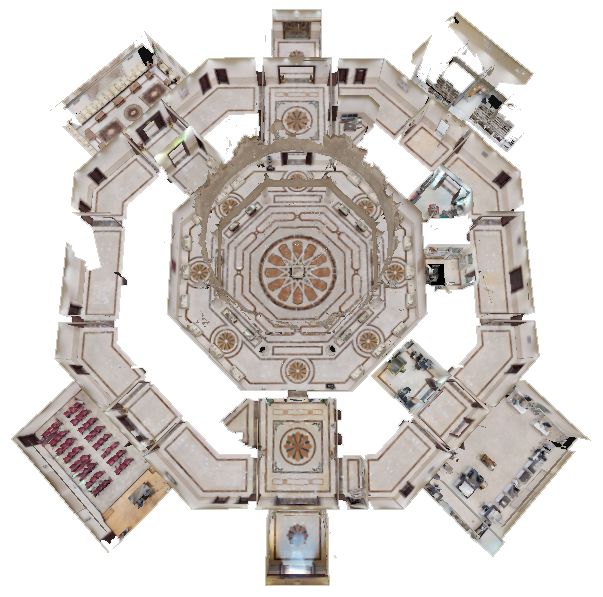 There is no doubt that HIS HIGHNESS SHEIKH DR. SULTAN BIN MOHAMMED ALQASIMI has spared no effort in spending on Islamic Manuscripts House, whether in construction or in providing it with the necessary equipment to perform its lofty mission in preserving the Islamic manuscripts with their underlying history, science, literature and others.
There is no doubt that HIS HIGHNESS SHEIKH DR. SULTAN BIN MOHAMMED ALQASIMI has spared no effort in spending on Islamic Manuscripts House, whether in construction or in providing it with the necessary equipment to perform its lofty mission in preserving the Islamic manuscripts with their underlying history, science, literature and others.
The House hired a well-known Spanish company specialized in supplying many of preservation and restoration equipment for manuscripts, valuables and materials for these purposes. This company is the main supplier of such equipment in the Middle East, Europe and America.
The main objective of the manuscript restoration is to return its durability and flexibility, which have been lost over time, to get closer to its original state, and to preserve it from any erasure, alteration, or obliteration of the material or intangible characteristics of the manuscript in terms of form, ink quality, writings and artistic features.
It is also important to distinguish between restored and non-restored parts, and to take into account that the restoration shall be distinctive and homogeneous to the manuscript, and the materials used are chemically treated, characterized by persistence to not be degrade or change over time, and can be removed, if necessary, without damaging the original manuscript.
The building consists of two floors, the first floor encompasses:
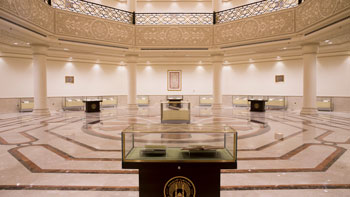 Exhibition Hall: a big hall topped by a marvelous Islamic-styled dome, and its walls are decorated with Andalusian Islamic ornaments that remind you of the ancient history.
Exhibition Hall: a big hall topped by a marvelous Islamic-styled dome, and its walls are decorated with Andalusian Islamic ornaments that remind you of the ancient history.
The Hall consists of two floors: The first floor covers the biggest part of exhibited articles, while the second floor seems like a balcony overlooking the main hall and covers another group of manuscripts.
The glass showcases (vitrines) of manuscripts are specially designed for keeping the valuable books and holdings. The glass is characterized by its lower refractive index and its metal is coated with an antibacterial and antifungal substance for protecting the manuscript from any damage that may be caused by such bacteria.
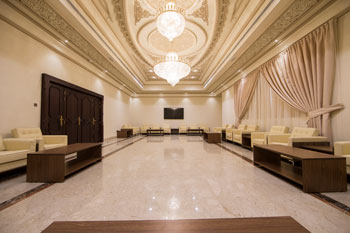 Assembly Hall: a sophisticated big state-of-the-art room, designed for hosting the top visitors and guests.
Assembly Hall: a sophisticated big state-of-the-art room, designed for hosting the top visitors and guests.
 Theater: It has seating capacity for around (50) persons and is equipped with the most advanced show equipment and sound and lighting systems. Events, courses, and seminars are held in this theater.
Theater: It has seating capacity for around (50) persons and is equipped with the most advanced show equipment and sound and lighting systems. Events, courses, and seminars are held in this theater.
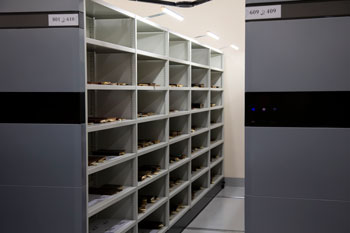 Manuscript Conservation Hall: It is a wide windowless hall, containing metal shelfs moving automatically slowly and smoothly. It is coated with an antibacterial and anti-parasitic substance for protecting the manuscripts. It endures high temperatures, which may reach 55 ° and keeps preserving the manuscripts inside it as much as possible.
Manuscript Conservation Hall: It is a wide windowless hall, containing metal shelfs moving automatically slowly and smoothly. It is coated with an antibacterial and anti-parasitic substance for protecting the manuscripts. It endures high temperatures, which may reach 55 ° and keeps preserving the manuscripts inside it as much as possible.
This hall also adheres to standard conditions for keeping the valuable manuscripts and holdings. The hall is provided with a temperature and humidity regulator to be within the averages suitable for the manuscripts, since the perfect temperature grade would be around (18° -20 °) and the perfect humidity grade would be around (50-55%).
In addition, the lighting intensity is adjusted to be below 50 lux. The cabinet fire extinguishing system is a smart system depending on reducing the oxygen level, where it falls around 13.5% to 20% inside the room from the normal oxygen level in the air.
Finally, the room door made of anti-heat thick iron plates, with big and broad edges for closing the room tightly and keeping temperature and humidity grade and the oxygen level within the safe averages. The door is only opened with a magnetic card, beside the normal lock.
For keeping the manuscript safe and secure, the hall is provided with surveillance cameras. In case the sensors record any rise in the oxygen level or change in temperature or humidity grades, the alarm bells will ring, referring to existence of a trouble in manuscript conservation to deal with it urgently.
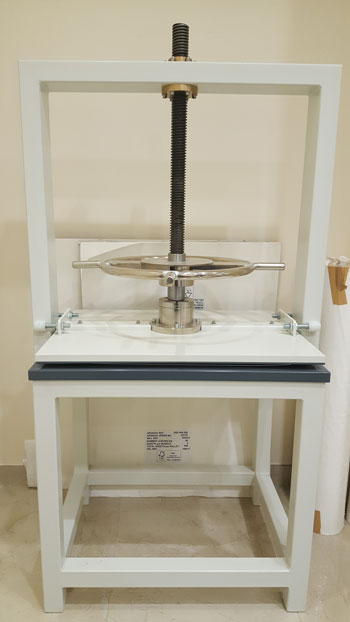 Bookbinding Laboratory: Bookbinding is the complementary part for preserving the rare manuscripts and books after finishing the repair and restoration. Bookbinding department rebind the books and manuscripts with natural or artificial leather and decorate them with gold ornaments to be similar to what was known at the age where the manuscript was written. The department is equipped with the modern tools and fittings needed and manual presses and machines for snipping and cutting papers and cartons.
Bookbinding Laboratory: Bookbinding is the complementary part for preserving the rare manuscripts and books after finishing the repair and restoration. Bookbinding department rebind the books and manuscripts with natural or artificial leather and decorate them with gold ornaments to be similar to what was known at the age where the manuscript was written. The department is equipped with the modern tools and fittings needed and manual presses and machines for snipping and cutting papers and cartons.
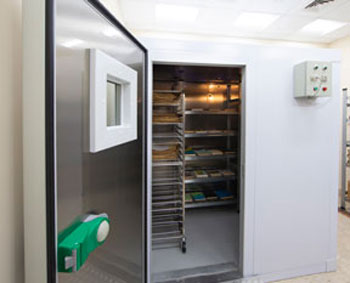 Manuscript Sterilization Room: This room contains a big sterilizer that relies on the technology of transferring air oxygen into Ozone, which is a harmless gas to the human health and has no effect in the environment, to be transferred to oxygen after finishing the manuscript sterilization.
Manuscript Sterilization Room: This room contains a big sterilizer that relies on the technology of transferring air oxygen into Ozone, which is a harmless gas to the human health and has no effect in the environment, to be transferred to oxygen after finishing the manuscript sterilization.
The sterilizer seems like a small room with a metal door tightly closed, containing metal shelfs inside where books are placed in a specific way, where they are kept open as much as possible, so that Ozone gas is spread throughout the papers, and a box for controlling the exposure time, ozone amount, and etc.
The sterilization process is conducted without use of any chemical substances, insecticides, or harmful gases, and without having an effect on the inks.
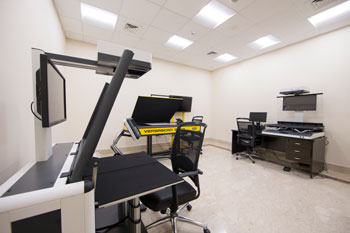 Photographing Room: The room contains three photographing devices produced by the top companies (Bookeye) and others. Such devices are connected with the server on which the photos are stored. Each device is different in terms of the resolution, where some resolutions reach 1200 DPI, and the size as well, where the biggest ones could capture the long rolled papers, maps, or others that need a large surface.
Photographing Room: The room contains three photographing devices produced by the top companies (Bookeye) and others. Such devices are connected with the server on which the photos are stored. Each device is different in terms of the resolution, where some resolutions reach 1200 DPI, and the size as well, where the biggest ones could capture the long rolled papers, maps, or others that need a large surface.
The photographing devices capture the manuscripts in their original colors and has an adjustable and balanceable base for avoiding compressing the manuscript counterfoil.
Repair and Restoration Laboratory: A big lab provided with multiple equipment that perform several aspects in the restoration process.
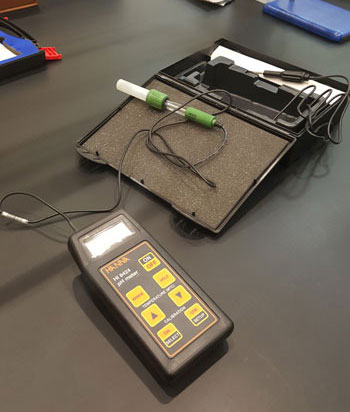 Acidity Measurement: Since there are different types of inks used throughout the ages in writing the manuscripts, including varieties of natural substances, ferric oxide, and others, and the manuscripts are exposed to air and sulfur dioxide, in addition to the time factor, the manuscript’s acidity is affected. This could affect the manuscript condition and its survival. Hence, there are devices for measuring the acidity percentage in papers (PH) and measuring the ink durability degree and the percentage of water or organic solvents influence. Accordingly, the proper substance is chosen for repairing the manuscript.
Acidity Measurement: Since there are different types of inks used throughout the ages in writing the manuscripts, including varieties of natural substances, ferric oxide, and others, and the manuscripts are exposed to air and sulfur dioxide, in addition to the time factor, the manuscript’s acidity is affected. This could affect the manuscript condition and its survival. Hence, there are devices for measuring the acidity percentage in papers (PH) and measuring the ink durability degree and the percentage of water or organic solvents influence. Accordingly, the proper substance is chosen for repairing the manuscript.
The device helps to determine the acidity degree and accordingly determine the concentration of the chemical substances used in the repair process, and balance the acidity.
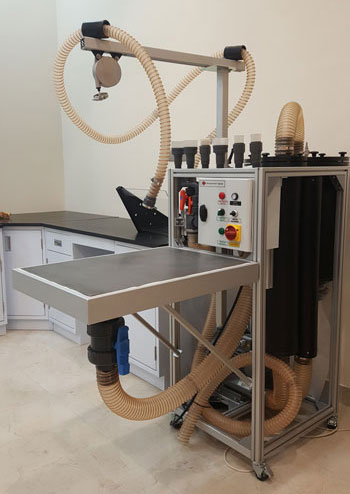 Manuscript Dry Cleaning Machine: It consists of a bored surface through which impurities pass, and brushes of different sizes and power with soft filaments connected with a suction device that cleans outer dusts and dirties caused by humidity, fungal, or microbes.
Manuscript Dry Cleaning Machine: It consists of a bored surface through which impurities pass, and brushes of different sizes and power with soft filaments connected with a suction device that cleans outer dusts and dirties caused by humidity, fungal, or microbes.
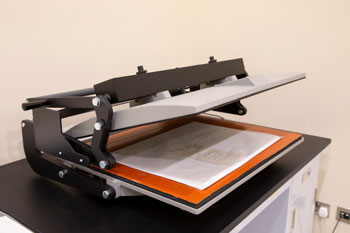 Laminator: It covers the worn out papers with a transparent case and by use of a thermopress whose temperature could be adjusted as per the type of the paper or the material of which the manuscript is made. This process aims to reinforce the paper and its flexibility and insulate the papers from the surrounding environment, which protects the papers from the surrounding harmful factors.
Laminator: It covers the worn out papers with a transparent case and by use of a thermopress whose temperature could be adjusted as per the type of the paper or the material of which the manuscript is made. This process aims to reinforce the paper and its flexibility and insulate the papers from the surrounding environment, which protects the papers from the surrounding harmful factors.
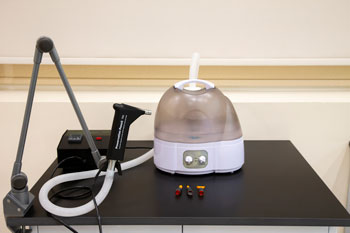 Sticky Papers Remover: It removes the sticky papers by directing steam technically through the moving part on the manuscript and it is used in case there are residues of sticky materials.
Sticky Papers Remover: It removes the sticky papers by directing steam technically through the moving part on the manuscript and it is used in case there are residues of sticky materials.
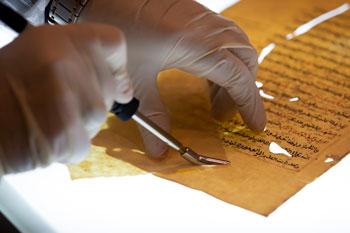 Manual Irons: Its use depends on the skill of the competent technician who blocks the holes by use of specialized paper prepared for restoration (Japanese paper), which are selected according to the manuscript type and color. A lighting board is used to show the tiny holes.
Manual Irons: Its use depends on the skill of the competent technician who blocks the holes by use of specialized paper prepared for restoration (Japanese paper), which are selected according to the manuscript type and color. A lighting board is used to show the tiny holes.
There are various rolls of Japanese papers and carboxymethyl cellulose adhesive with different colors and thicknesses.
There are also refrigerators to keep the chemical substances and a room for preparing the chemical solutions to keep the people and place safe.
While the second floor encompasses:
 Periodicals Hall: It contains periodical publications and magazines focusing on heritage and manuscripts.
Periodicals Hall: It contains periodical publications and magazines focusing on heritage and manuscripts.
Rare Prints Conservation Hall: It includes rare lithographic print books and old prints made more than 60 years ago.
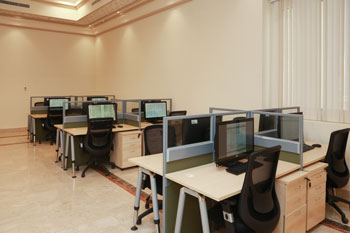 Digital Manuscripts Accessing and Reading Halls: They are places that are equipped with touch-screen computer devices to facilitate approaching the manuscript and reading its content, and they are connected with the master server that feed them with photographed manuscripts.
Digital Manuscripts Accessing and Reading Halls: They are places that are equipped with touch-screen computer devices to facilitate approaching the manuscript and reading its content, and they are connected with the master server that feed them with photographed manuscripts.
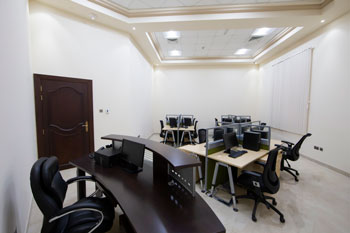 Original Manuscripts Accessing and Reading Halls: They are places where the researcher could have access to the original manuscript, upon fulfilling specific conditions, and under the supervision of a competent employee.
Original Manuscripts Accessing and Reading Halls: They are places where the researcher could have access to the original manuscript, upon fulfilling specific conditions, and under the supervision of a competent employee.
Investigation and Publication Halls: These halls provide a calm academic environment, where the researcher could have access to all academic sources needed in his research, including any manuscript, periodical, or website.




